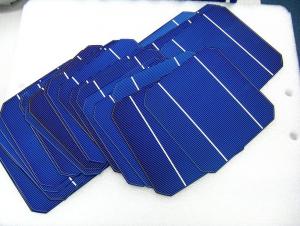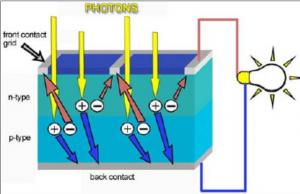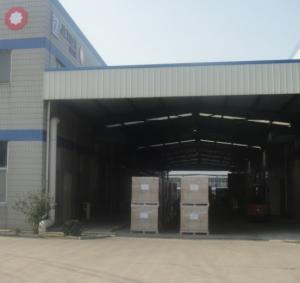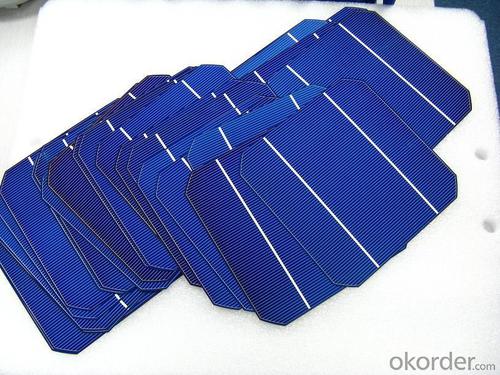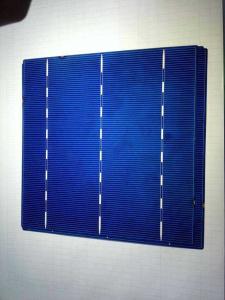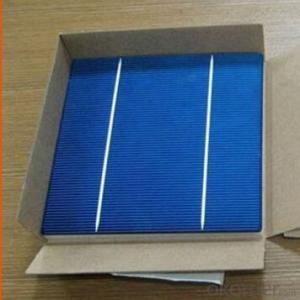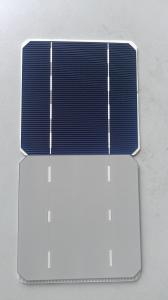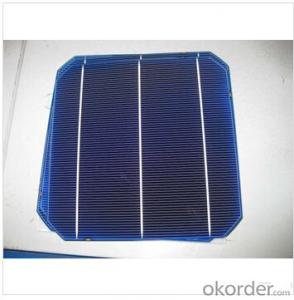Third Generation Solar Cells - Mono Solar Cell 125mm x 125mm x 0.5mm
- Loading Port:
- China main port
- Payment Terms:
- TT or LC
- Min Order Qty:
- 40000 watt
- Supply Capability:
- 100000 watt/month
OKorder Service Pledge
OKorder Financial Service
You Might Also Like
Details Of Mono Solar Cell 125mm
Specifications Of Mono Solar Cell 125mm
1.Mechanical data and design
Format | 125 mm × 125 mm ± 0.5 mm |
Thickness | 210 μm ± 40 μm |
Front(-) | 1.6 mm bus bars (silver),blue anti-reflection coating (silicon nitride) |
Back (+) | 2.5 mm wide soldering pads (silver) back surface field (aluminium) |
2.Temperature Coefficient of Cells
Voc. Temp . coef.%/K | -0.35%/K |
Isc . Temp . coef.%/K | +0.024%/K |
Pm. Temp. coef.%/K | -0.47%/K |
3.Electrical Characteristic
Efficiency(%) | Pmpp (W) | Umpp (V) | Impp (A) | Uoc (V) | Isc (A) | FF (%) |
18.35 | 2.841 | 0.532 | 5.342 | 0.631 | 5.67 | 79.41% |
18.20 | 2.817 | 0.53 | 5.319 | 0.631 | 5.64 | 79.16% |
18.05 | 2.794 | 0.527 | 5.301 | 0.63 | 5.63 | 78.77% |
17.90 | 2.771 | 0.527 | 5.259 | 0.629 | 5.62 | 78.39% |
17.75 | 2.748 | 0.526 | 5.224 | 0.629 | 5.61 | 77.88% |
17.60 | 2.725 | 0.524 | 5.201 | 0.629 | 5.59 | 77.50% |
17.45 | 2.702 | 0.52 | 5.196 | 0.629 | 5.586 | 76.90% |
17.30 | 2.678 | 0.516 | 5.183 | 0.626 | 5.577 | 76.71% |
17.15 | 2.655 | 0.513 | 5.175 | 0.623 | 5.565 | 76.58% |
17.00 | 2.632 | 0.51 | 5.161 | 0.622 | 5.559 | 76.12% |
16.75 | 2.593 | 0.508 | 5.103 | 0.615 | 5.477 | 76.98% |
16.50 | 2.555 | 0.506 | 5.047 | 0.608 | 5.396 | 77.88% |
4.Intensity Dependence
Advantage Of Mono Solar Cell 125mm
1: high quality cell, Level A cell (16.50%—18.35%)
2: Dimensione:125*125mm Diagonal:150mm / 165mm
Dimensione:156*156mm Diagonal:200mm
3: Qualified certification: TUV,CE certification.
4: Warranty: five years for whole unit
Usage/Application Of Mono Solar Cell 125mm
Packaging & Delivery Of Mono Solar Cell 125mm | |
Packaging Detai | Packaging Detail:Export Carton and Pallet or under customer request. |
Delivery Detail:10-20days | |
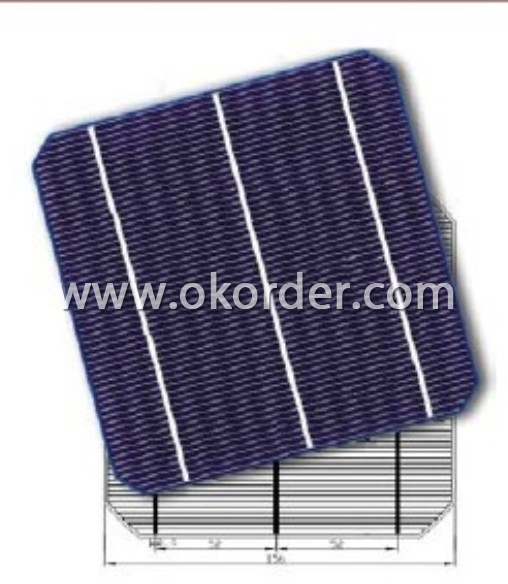
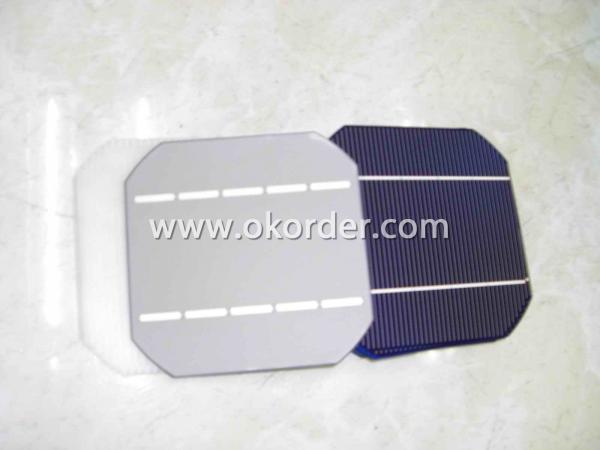
Converting the sun’s radiation directly into electricity is done by solar cells. These cells are made of semiconducting materials similar to those used in computer chips. When sunlight is absorbed by these materials, the solar energy knocks electrons loose from their atoms, allowing the electrons to flow through the material to produce electricity. This process of converting light (photons) to electricity (voltage) is called the photovoltaic effect.
When photons are absorbed by matter in the solar cell, their energy excites electrons higher energy states where the electrons can move more freely. The perhaps most well-known example of this is the photoelectric effect, where photons give electrons in a metal enough energy to escape the surface. In an ordinary material, if the electrons are not given enough energy to escape, they would soon relax back to their ground states. In a solar cell however, the way it is put together prevents this from happening. The electrons are instead forced to one side of the solar cell, where the build-up of negative charge makes a current flow through an external circuit. The current ends up at the other side (or terminal) of the solar cell, where the electrons once again enter the ground state, as they have lost energy in the external circuit.
Solar cells, which were originally developed for space applications in the 1950s, are used in consumer products (such as calculators or watches), mounted on roofs of houses or assembled into large power stations. Today, the majority of photovoltaic modules are used for grid-connected power generation, but a smaller market for off-grid power is growing for remote areas and developing countries.
Given the enormous potential of solar energy, photovoltaics may well become a major source of clean electricity in the future. However, for this to happen, the electricity generation costs for PV systems need to be reduced and the efficiency of converting sunlight into electricity needs to increase. To achieve this, the Commission supports photovoltaics development since many years by funding research projects and facilitating cooperation between stakeholders.
- Q: What factors affect the efficiency of solar cells?
- Several factors can affect the efficiency of solar cells, including the quality and purity of the materials used, the design and construction of the cells, the amount of sunlight received, the temperature, and any external shading or obstructions. Additionally, the angle and orientation of the solar panels, as well as the presence of dirt or dust on the surface, can also impact the efficiency of solar cells.
- Q: Can solar cells be used in emergency lighting?
- Yes, solar cells can be used in emergency lighting. Solar cells are capable of converting sunlight into electrical energy, which can be stored in batteries for later use. This makes them a reliable and sustainable option for emergency lighting, as they can provide power during power outages or in remote areas where traditional electricity sources may not be available.
- Q: Can solar cells be used for indoor applications?
- Yes, solar cells can be used for indoor applications. While solar cells are primarily designed to harness sunlight and convert it into electricity, they can also generate power from indoor lighting sources such as fluorescent or LED lights. However, the amount of electricity generated indoors is generally lower compared to outdoor conditions due to the reduced intensity of indoor lighting. Nonetheless, solar cells can still be used effectively for powering small devices or charging batteries in indoor settings.
- Q: What are the advantages of monocrystalline silicon and polycrystalline silicon in solar power?
- In the use of solar energy, monocrystalline silicon and polysilicon also play a huge role. Although the current terms, to make solar power has a larger market, the majority of consumers to accept, we must improve the efficiency of solar cell photoelectric conversion, reduce production costs. From the current development of international solar cells can be seen that the development trend of monocrystalline silicon,
- Q: What is the lifespan of solar cell batteries?
- The lifespan of solar cell batteries can vary depending on several factors, including the quality of the battery, usage patterns, and maintenance. On average, solar cell batteries can last anywhere between 5 to 15 years. However, with proper care and maintenance, some high-quality batteries have been known to last up to 20 years or more.
- Q: Friends are fuel cells are chemical energy into electricity, solar cells are converted into electricity into electricity I would like to know in addition to the structure and the conversion of different ways there are no other differences hope that the specific power of everyone
- At present fuel cell system fuel - power conversion efficiency of 45% to 60%, while the thermal power and nuclear power efficiency of about 30% to 40%. (2) Hazardous gases SOx, NOx and noise emissions are low CO2 emissions are greatly reduced due to high energy conversion efficiency, no mechanical vibration.
- Q: How do solar cells perform in coastal areas?
- Solar cells perform well in coastal areas due to the abundance of sunlight and the absence of obstructions that could potentially shade the panels. Additionally, the coastal breeze helps to keep the solar panels cool, preventing overheating and improving their overall efficiency.
- Q: What is the impact of dust storms on solar cell efficiency?
- Dust storms have a negative impact on solar cell efficiency. The accumulation of dust particles on the surface of solar panels obstructs sunlight from reaching the photovoltaic cells, reducing their ability to convert sunlight into electricity. This dust buildup decreases the overall power output of the solar panels and requires regular cleaning and maintenance to maintain optimal efficiency.
- Q: Can solar cells be used to power remote oil and gas monitoring systems?
- Yes, solar cells can be used to power remote oil and gas monitoring systems. Solar cells are a reliable and sustainable source of renewable energy that can be used to generate electricity in remote locations where access to the grid is limited. By harnessing the power of the sun, solar cells can provide a continuous supply of electricity to power monitoring systems for oil and gas operations, ensuring efficient and reliable monitoring in remote areas. Additionally, solar power offers environmental benefits by reducing reliance on fossil fuels and minimizing carbon emissions.
- Q: How do solar cells handle voltage fluctuations?
- Solar cells handle voltage fluctuations through the use of voltage regulators or charge controllers. These devices ensure that the voltage output from the solar cells remains stable and within a safe range by regulating the flow of current. This helps to protect the solar cells from damage and ensures efficient power generation.
1. Manufacturer Overview
| Location | SanShui City, Guang Dong, China. |
| Year Established | 2009 |
| Annual Output Value | Above 10 billion RMB |
| Main Markets | Mid East;Western Europe;North America;Southeast Asia |
| Company Certifications | TUV ISO9001;SGS |
2. Manufacturer Certificates
| a) Certification Name | |
| Range | |
| Reference | |
| Validity Period |
3. Manufacturer Capability
| a) Trade Capacity | |
| Nearest Port | Zhuhai, Foshan |
| Export Percentage | 0.4 |
| No.of Employees in Trade Department | about 600 |
| Language Spoken: | English;Chinese; |
| b) Factory Information | |
| Factory Size: | 66666.7m2 |
| No. of Production Lines | 12 |
| Contract Manufacturing | OEM Service Offered;Design Service Offered |
| Product Price Range | USD 0.3-0.45/Wp |
Send your message to us
Third Generation Solar Cells - Mono Solar Cell 125mm x 125mm x 0.5mm
- Loading Port:
- China main port
- Payment Terms:
- TT or LC
- Min Order Qty:
- 40000 watt
- Supply Capability:
- 100000 watt/month
OKorder Service Pledge
OKorder Financial Service
Similar products
Hot products
Hot Searches
Related keywords
